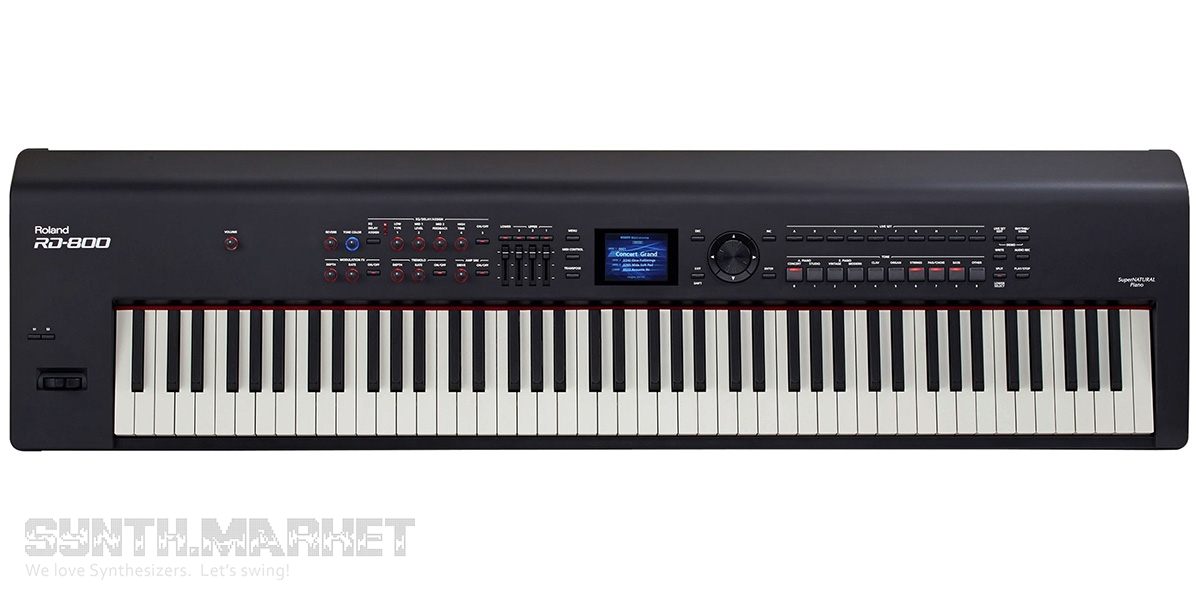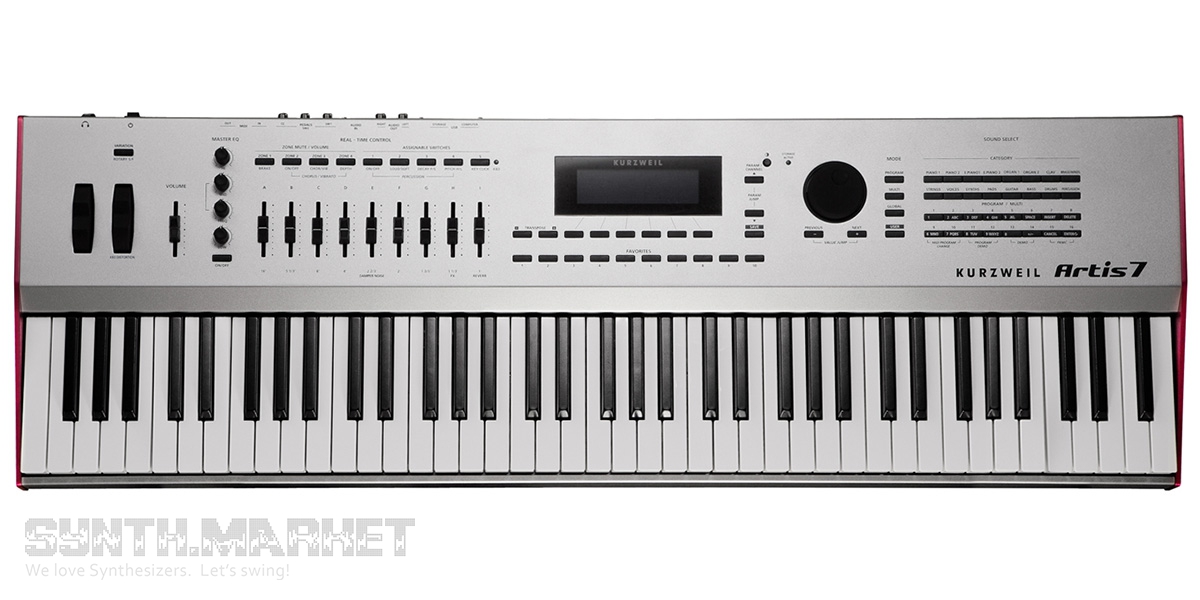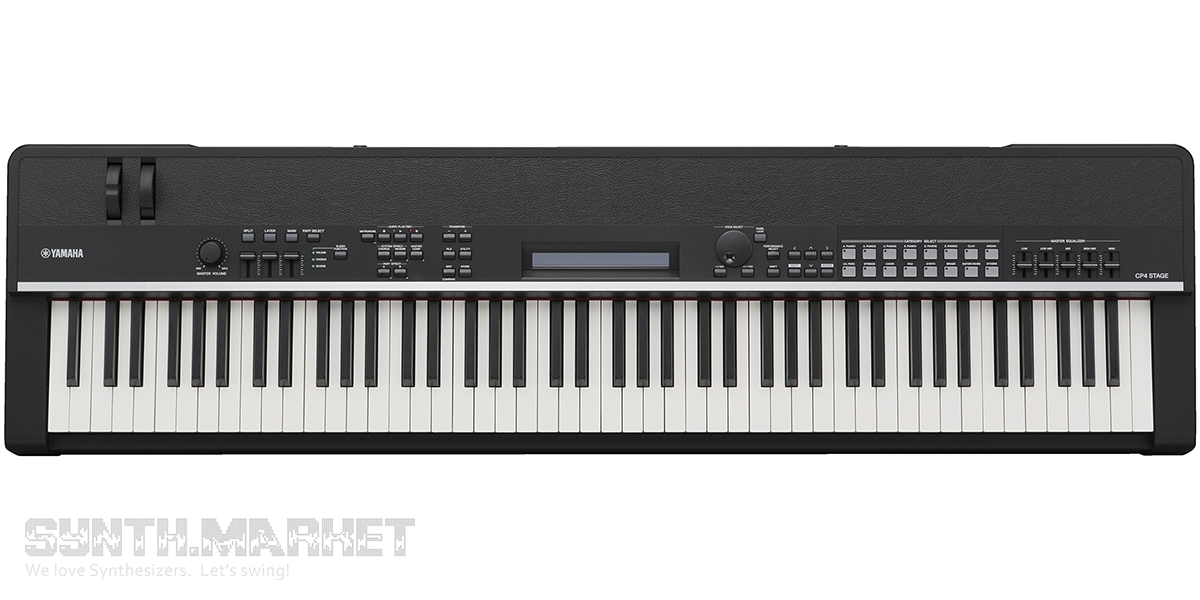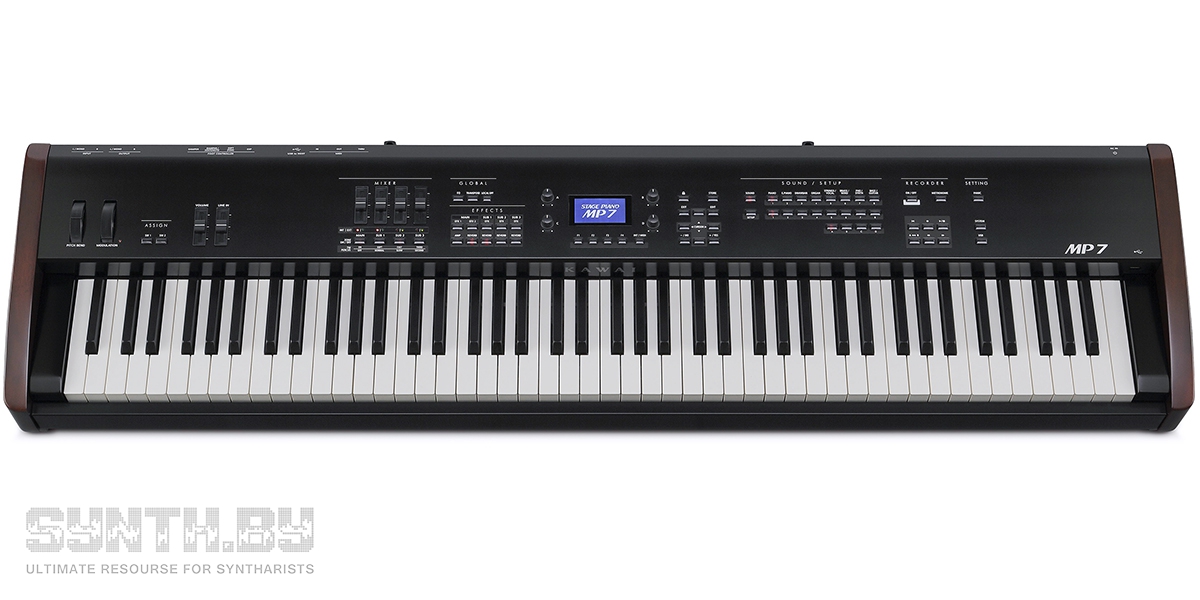RD-800 sporting a fully weighted key action can replace Roland Jupiter-80 - in a way, of course - due to its affordability. It also focuses our attention on the “tone” itself and alterations around it and not on the actual patches and programs. RD-800 allows editing the tone and its concomitant settings, anyway it can’t save it and store among the other already existing tones: a user tone just “lives” as one of the 4 parts (3 upper ones and 1 lower) of the live set.
Each of the tones is generated by one of the 5 sources among which there are 40 SuperNATURAL pianos, 50 SuperNATURAL electric pianos, 20 SuperNATURAL harpsichords, 10 virtual tonewheel organs and other sounds belong to the PCM engine (including 22 drum kits). There are 300 factory presets in total.
SuperNATURAL tones don’t allow profound editing but considering their original quality we might say the deep programming isn’t necessary. The menu for the key sounds is full-represented parametrically: damper amplitude, string resonance, hammer noise as well as “nuance” and “character”. There are also some sound correcting editor-functions adopted from Roland V-Piano.
Many piano voices in RD-800 almost don’t differ from those you expect from a real acoustic instrument- they surpass the closest competitors regarding the softness and depth expressing involvement into each note making its character clearly present.
The electric piano sounds offer 7 settings options while Clavs – only 4, but the synthesizer already features all the crucial Wurli and Rhodes emulations or re-created electric pianos based on SAS technology as well as superfine harpsichords.
While developing organ sounds Roland relied upon the brand quality and limited the editing possibilities here as well: for example, there's no Hammond chorus/vibrato effect. Anyway the front panel controllers didn’t contribute to this section either.
PCM sound section is packed with… same scarcity of editing possibilities. The sounds cover all the standard categories and the effects are available within attack/decay/release, resonance, portamento and vibrato option range.
Talking about the effects we should say that each tone carries only one modulation choice. And though modulation represents a humble number of chances to alter the sound there are a few types of tremolo, panning and a rotary speaker simulation. Each live set can be put through 3 effects: delay, reverb and a 5-band equalizer. You can also find a global 3-band compressor there.
Plus we should admit that limitations might be also an advantage for a keyboard – thanks to the minimum of editing RD-800 is simple and easy in use during live performances. It’s not a workstation, it’s a stage keyboard with the new advanced PHA4 hammer action considering the topflight quality of which we may assure all those who’re willing to buy a stage piano - they don’t need their instrument to be laden with options, they’re going to be happy with that sober, reasonable amount of controls planned by sage engineers of Roland. There’s a sweet bonus – colorful and big enough display (comparing to those of the rival keyboards).
Kurzweil Artis took the sound set from PC3K though features not all of the programs. Anyway its basic configuration has something precious to offer – German D Piano which is available for PC3K only as a premium option. Artis is based on the same DSP but features an elaborated interface with an easy access to all the voices and all the editing. All the valuable real time control parameters have 5 assignable buttons and 9 sliders (SE version – only 4), 3-band master equalizer near the volume control, transpose buttons (over the pitch/mod wheels) assignable depending on the Variation button program and assignable depending on the mode of the button under the screen. Besides, under these ones there’s the row of 10 more buttons triggering favorite sounds.
Artis series has three variants. Artis (sometimes called Artis 8) uses the Fatar TP-100/LR keyboard with hammer action - quite good for playing non-piano arpeggio which usually needs fully-weighted keys to sound convincing. Artis 7 – that beautiful silver keyboard with red sides of light alloy – features a semi-weighted Fatar TP8 76-note keybed. Artis and Artis 7 models are included in our review.
Nevertheless we’ll hold out attention on the most budget variant as much as most questionable one – Artis SE. Here we’re going to be surprised – it sports a fully-weighted keyboard (the same one Artis 8 features) but a severely stripped down interface and a small display (the same one SP4/ SPS4/ SP5 series had). So if you want to cut down on superfluous features and save the money we’d recommend focusing on purchasing SP5-8 – it’s 15% cheaper but has the same keyboard, same small screen and 3 times as many factory presets as Forte SE does. It isn’t worth it to overpay $200 for German D Piano because there are plenty of splendid key voice programs. Although it seems that it would be fair enough to put Artis SE and SP5-8 together with Yamaha CP40 Stage, Kawai ES8 and Roland FP-80 which are of a bit lower prestige level than those instruments we analyze today.
Let’s go back to Artis. The intense palette featuring 256 programs is built upon PC3K, PC3 and KB3 sounds. PC3 offers a great selection of EP, Clav voices and 16 string programs, KB3 organ sounds have all the needed settings to reveal their character within the stage piano limits (percussion, vibrato/chorus, key click, tonewheel damping). German Grand Piano shines with all its detailed nuances thanks to the powerful VAST basis with the programs capable of carrying up to 32 layers. There are no drum patterns but a serious bank of drum sounds is available – it was taken from Kore64 expansion. 256 slots are here to store your programs although the editing is limited because Kurzweil has already assigned some parameters to controllers within certain programs, but a software editor will be a solution. Any 4 programs can be layered and split across the keyboard.
Considering that Dynamic VAST real time engine options are truly inexhaustible, Artis took care of performing functions: in a program mode any motion of a slider is displayed showing the parameter which is being controlled – that’s how you won’t have to dig for strong intuition skills in your fathomless patience; in a multi mode the first 4 sliders control the volume of the 4 zones and the buttons located underneath are busy with their activating/deactivating.
Artis which is based mainly on PC3K series got a different keyboard, simplified the interface, replaced flash memory with 128 Mb ROM for pianos, focused on key sounds and dropped in price becoming a real stage bargain comparing to PC3K/PC3A series.
The rear panel features a moderate number of integration possibilities: two jacks for conventional TRS pedals or dual ones. A separate jack - for a continuous control pedal. There are two USB ports for a computer and a flash drive with the recorded programs. A stereo 1/8" input - for connecting your favorite MP3 player or other audio source for accompaniment playback.
Since Artis is much cheaper than PC3K as well as RD-800 and CP4 reviewed here it’s obvious that touring musicians who’re fond of Kurzweil should have no doubts about that – Artis is the right choice.
Yamaha released CP4 Stage after 4 years they launched a heavy-pricey CP1. CP4 Stage was created in order to fill the niche of compact and affordable stage instruments. Having cut the price in half the company worked on the instrument’s portability; the keyboard got a 3-part operation (Main, Layer and Split).
The keys imitate the real piano ones (Natural Wood Graded Hammer new technology) are made of wood featuring the ivory-feel coating and produce acoustic and electric piano sounds better than any plastic equivalent. As any respectable stage piano CP4 Stage offers the range of key voices which sound perfect even when pure not enhanced with effects: CFX sounds inspire to create solo as well as ensemble, CF ones deserve as much attention as they did in CP1, S6 samples are a bit more subtle here so they will stream naturally with the overall flow not overburdening it and not disappearing in harmonics either. The instrument has 45 own programs of top Yamaha grand pianos, 47 vintage electric piano programs and 341 programs of other key instruments taken from Motif flagship workstation library.
Modeled electric piano sounds can be easily mistaken for authentic ones, each type has its own preamp, the section allows tweaking settings of the virtual piano components.
Besides a 5-band equalizer any voice has 2 built-in effects, chorus block, reverb block and master compressor available.
On the whole there are 433 sounds onboard and as for the effects CP4 Stage features really smooth panning, great vintage compressors and a VCM (Virtual Circuitry Modeling) analog emulation engine. Of course, it’s far from Motif line capabilities, there’s no multitrack sequencer and it’s light-weighted due to the lack of built-in speakers. But here we care about the price issue and try to figure out if all the basic attributes of a quality stage keyboard are featured – whatever price we talk about a good stage instrument should have convincing emulations and brand sounds as well as a keyboard ready to deliver the voices at their best. And CP4 surely proves to be worthy.
CP4 Stage has one peculiarity: user voice mode is unavailable for monophonic programs – all the saved results go to multitimbral performance only; Main part will always be the active one while Layer and Split can be lost if some sound doesn’t support polyphony.
The connectivity features 5 pin MIDI, foot switch and controller jacks, stereo 1/8” input, 1/4" outputs, XLR outputs for the router direct connection on stage, USB-B for Windows or Mac integration, USB-A for WAV stereo recording onto an external device. Besides, CP4 Stage has its own built-in power supply.
The professional CP4 Stage is light enough, sports the great selection of key sounds and a really nice piano keyboard – it’ll remind you what it feels like to play the piano.
Kawai responded to their industry colleagues striking the market with MP7 stage piano which can boast a classy 7-octave keyboard with weighted velocity sensitive keys with triple-sensor key detection. This keyboard makes you feel playing Kawai EX Concert Grand Piano and even has some tricks, such as key counterweights in the lower octaves, for example. Professional pianists who got used to concert pianos agree that Kawai offers one of the most suitable keyboards which won’t have you compromising while RD-800 and CP4 Stage are not so conventional and seem to be good for multi-instrumentalists. And Kurzweil feels alright having Artis series equipped with the Italian “passe-partout” keyboards which upset the virtuosos so much.
Kawai MP7 has always had a bigger polyphony than its competitors – 256 notes, and it’s not the ultimate possible number but just the minimum for the EX grand piano series sample library. MP7 maintains another Kawai tradition: a few number of factory presets – 8 sections include 256 programs in total. There are 7 reverb types and 20 other classic effects (chorus, flanger, delay, tremolo, phase shift, rotary, overdrive and etc.) which can be assigned individually to each of the 4 possible keyboard zones. All zones are freely assignable and feature independent settings for dynamics, splits and layers.
The interface includes pitch wheels, assignable sliders, basic functions control buttons and a two-line monochrome display with backlight.
The connectivity is standard as well: MIDI in/out, stereo output 6.3 mm jacks, XLR outputs, 3 jacks for sustain, expression pedals and assignable functions. Basic configuration includes F-10 dual pedal with half damper support. USB support.
When there are top brands producing these truly fine mid-range instruments and there are customers willing to purchase a great piano keyboard with excellent sounds then there are easy options as well - the reviewed models are the best choices in a mid-range category. The full list of the digital pianos of any price category is available for you in our catalogue of electronic musical instruments.





